Design and Technology > AS Mark Scheme > GCE Design and Technology H404/02: Problem solving in Design Engineering Advanced GCE Mark Scheme fo (All)
GCE Design and Technology H404/02: Problem solving in Design Engineering Advanced GCE Mark Scheme for Autumn 2021
Document Content and Description Below
Oxford Cambridge and RSA Examinations GCE Design and Technology H404/02: Problem solving in Design Engineering Advanced GCE Mark Scheme for Autumn 2021Oxford Cambridge and RSA Examinations OCR (... Oxford Cambridge and RSA) is a leading UK awarding body, providing a wide range of qualifications to meet the needs of candidates of all ages and abilities. OCR qualifications include AS/A Levels, Diplomas, GCSEs, Cambridge Nationals, Cambridge Technicals, Functional Skills, Key Skills, Entry Level qualifications, NVQs and vocational qualifications in areas such as IT, business, languages, teaching/training, administration and secretarial skills. It is also responsible for developing new specifications to meet national requirements and the needs of students and teachers. OCR is a not-for-profit organisation; any surplus made is invested back into the establishment to help towards the development of qualifications and support, which keep pace with the changing needs of today’s society. This mark scheme is published as an aid to teachers and students, to indicate the requirements of the examination. It shows the basis on which marks were awarded by examiners. It does not indicate the details of the discussions which took place at an examiners’ meeting before marking commenced. All examiners are instructed that alternative correct answers and unexpected approaches in candidates’ scripts must be given marks that fairly reflect the relevant knowledge and skills demonstrated. Mark schemes should be read in conjunction with the published question papers and the report on the examination. © OCR 2021H404/02 Mark Scheme October 2021 01. Annotations Annotation Meaning Blank Page – this annotation must be used on all blank pages within an answer booklet (structured or unstructured) and on each page of an additional object where there is no candidate response. Tick Cross Confused (replaces the question mark) Benefit of doubt AO1 – Knowledge and understanding AO2 – Apply knowledge and understanding AO3 - Analyse AO4 - Evaluation Omission Not answered question Noted but no credit given Too vague Own figure rule RepetitionH404/02 Mark Scheme October 2021 2. Subject Specific Marking Instructions INTRODUCTION Your first task as an Examiner is to become thoroughly familiar with the material on which the examination depends. This material includes: • the specification, especially the assessment objectives • the question paper • the mark scheme. You should ensure that you have copies of these materials. You should ensure also that you are familiar with the administrative procedures related to the marking process. These are set out in the OCR booklet Instructions for Examiners. If you are examining for the first time, please read carefully Appendix 5 Introduction to Script Marking: Notes for New Examiners. Please ask for help or guidance whenever you need it. Your first point of contact is your Team Leader.H404/02 Mark Scheme October 2021 Content Level of response 1* Indicative content: Candidates will be expected to make reference to the Resource Booklet in their answer and also demonstrate their understanding of the environmental impacts that technology advancements have delivered. Their answers could include but not be limited to: • An increase in manufacturing to feed people’s appetite for new technology. • Industrialisation put ahead of environmental concern, especially in developing countries. • Air pollution – the increase in carbon dioxide and other gases through the manufacturing processes, and increased use of fossil fuels. The increase in Carbon Monoxide from increase in traffic both, air, land and sea. • Global warming from the increased emission of greenhouse gases, predominantly from burning fossil fuels. • Water pollution – Candidates could mention about the pollution in water from: Plastic disposed in the seas, industrial pollution being dumped in the oceans and rivers, how agriculture adds to water pollution and also about how domestic pollution adds to the affect. • Pollution caused by throw-away society and failure to recapture materials. • Depletion of natural resources – Through the over mining of materials. Candidates could mention about the building of infrastructures to facilitate the technological advancement i.e. Super Factories, Cities, Lakes as a result of Damming rivers. Candidates could mention about the depletion of the rain forests for timber or farming. • Increase in energy consumption – Candidates could make reference to the increase in energy 14 All responses should be in relation to the affects that technological progression has had on the environment. Candidates should be responding with both the negative and positive affects technology has had. Any lifted information can be used in support of the critical examination but no marks should be awarded simply for duplicating text. Credit should be given for responses which identify issues evident in the supplied information and which are then critically analysed and evaluated in terms of their significance to the given scenario and relating to design and technical principles. Level 4 (11-14 marks) A comprehensive discussion of environmental impacts. Comprehensive understanding of a wide range (at least three) of impacts that technological progression has had on the environment. Both positive and negative impacts have been included. Information in Resource Booklet and own examples are used effectively to fully exemplify the points being made. Well-constructed narrative in relation to question with clear and supported evaluative comments. There is a well-developed line of reasoning which is clear and logically structured. The information presented is relevant and substantiated. Level 3 (7-10 marks) A good discussion of environmental impacts. Good understanding of a range (at least 2) of impacts that technological progression has had on the environment. Positive and/or negative impacts have been included. Information in Resource Booklet and own examples are used for the most part effectively to exemplify points being made although one or two opportunities are missed. Well-considered narrative in relation to question although one or two opportunities missed to developH404/02 Mark Scheme October 2021 demands as a result of the increase in technology and the affect this will have on the environment. Could mention increase in the use of Coal or Gas power stations. • Reference made to the graph in Fig 2, and the future projections of the different energy types. • Hidden energy needs of digital systems such as the internet or mobile networks. • Positives of technological advancement- It is important the candidates get a balanced response so there should be an example of where technology has helped the environment. Ideas could be but are not limited to: Renewable energy designs, Electric/hybrid/hydrogen cars, better standard of living because of electrification of homes. • Any other valid suggestion. response. Evaluative comments are clear but not always supported. There is a line of reasoning presented with some structure. The information presented is in the most part relevant and supported by some evidence. Level 2 (4–6 marks) A sufficient discussion of environmental impacts. Sufficient understanding of impacts (at least 1) that technological progression has had on the environment. Positive and/or negative impacts have been included. Information in Resource Booklet and/or own examples are used to exemplify some points being made although much more could have been done to exploit the stimulus available/draw on one’s own understanding. Reasonable narrative in relation to the question although response at times lacks depth and cohesion. Evaluative comments lack clarity and are unsupported. The information has some relevance and is presented with limited structure. The information is supported by limited evidence. Level 1 (1–3 marks) A limited discussion of environmental impacts. Limited knowledge and next to no understanding of impacts that technological progression has had on the environment.H404/02 Mark Scheme October 2021 Use of information from the Resource Booklet is used in a simple way and adds little value to the points being made. Limited attempt to draw on own examples. Limited narrative in relation to question. Response is basic with no evaluative comments. The information is basic and communicated in an unstructured way. The information is supported by limited evidence and the relationship to the evidence may not be clear. 0 marks No response or no response worthy of credit.H404/02 Mark Scheme October 2021 Question Answer Mark Guidance 2 Within the answer candidates should be making reference to a product or system and the different parts of the product life cycle. Within their answer they could consider the following: Development: • Reference to the materials that the product is made from, the use of recycled materials, renewable/upcycled/eco materials etc. • Products designed to be modular with easy to replace parts to prolong the products life in service. • Manufacturing methods should be considered for the components. Looking at efficient systems to reduce the carbon footprint and reduce pollution and waste. • RoHS considerations during material and component choice. • Chose local manufacturing options to reduce the carbon footprint and invest in local resources. • Design for maintenance and repair. Introduction: • Use a digital system, online advertising, Apps, using a digital format for advertising will reduce the carbon footprint. • Online sales. • Using recycled packaging for shipping. Maturity: • Produce upgrades to the systems to prolong the maturity phase and put off the decline. • Maintain online advertising throughout period to increase sales. • Think of product extensions, add-ons, upgrades etc. • Product support. Decline: • EOL considerations. • Ensure that the parts of the product can be readily recycled. • Use fewer parts, and fewer different materials. 14 Content Level of Response All responses should be in relation to the affect the designer could have on the products impact to the environment. Candidates may extract information from any part of the Resource Booklet but specifically page 3 (and possibly page 2). Any information should be critically evaluated or applied to the question and no marks should be awarded for simply copying the text. Credit should be given for responses which identify issues evident in the Resource Booklet and which are critically analysed and evaluated in terms of the significance to the given scenario and relating to the PLC with reference to a specific product of their choice. Candidates can use the example in the resource booklet but should not be credited for just copying the text. Candidates are expected to draw on their own knowledge of products past and present. Level 4 (11-14 marks) A comprehensive critical evaluation of the ways a design engineer can reduce the impact their decisions have on the environment at the different stages of the product life cycle. Comprehensive product knowledge in evidence. Analysis of how environmental impact can be reduced is consistently and appropriately aligned with the different stages of the PLC. Information in the Resource Booklet is used effectively to fully exemplify the points being made. Level 3 (7-10 marks) A good critical evaluation of the ways a design engineer can reduce the impact their decisions have on the environment at the different stages of the product life cycle. Good product knowledge in evidence. Analysis of how environmental impact can be reduced is appropriately aligned with the different stages of the PLC although one or two opportunities are missed to make connections. Information in the Resource Booklet is used for the most part effectively to exemplify points being made although one or two opportunities are missed. Level 2 (4-6 marks)H404/02 Mark Scheme October 2021 • Ensure that products when disposed of don’t harm the environment when they break down. i.e. Batteries etc. • Can the product be reused in any way, either for a similar purpose or for a different application (upcycled). In all cases any other valid suggestion. A sufficient critical evaluation of the ways a design engineer can reduce the impact their decisions have on the environment at the different stages of the product life cycle. Sufficient product knowledge in evidence. Analysis of how environmental impact can be reduced is reasonably aligned with the different stages of the PLC although significant opportunities are missed to make connections. Information in the Resource Booklet is used to exemplify some points being made although much more could have been done to exploit the stimulus material available. Level 1 (1-3 marks) A limited examination of the ways a design engineer can reduce the impact their decisions have on the environment at the different stages of the product life cycle. Limited product knowledge in evidence. Isolated statements made in relation to how environmental impact can be reduced resulting in only weak alignment with PLC. Use of information from the Resource Booklet is used in a simplistic way and adds limited value to the points being made. 0 marks No response or no response worthy of credit.H404/02 Mark Scheme October 2021 Question Answer Mark Guidance 3 16 Each solution will reflect a Level 1 to 4. The combination of the two Levels needs to be taken into account when fixing the final mark to be awarded. Candidates may present evidence worthy of marks in various ways, including written notes, annotated sketching and calculations. Issue 1 Candidates are looking to design a mechanism that is capable of converting reciprocating motion into rotary motion and multiplying the frequency by 3. Conversion of motion: Award marks for drawing a system which could convert the motion as requested. Answers could include but are not limited to: • Crank and Slider, • Reciprocating Rack and pinion. Diagram should clearly indicate the directions of the motions (probably using arrows). Multiplying the motion: Level 4 (13-16 marks) A comprehensive demonstration of technical solutions to overcome the two issues identified. Comprehensive understanding of technical design and technology principles to overcome the two issues identified. Both solutions are welldeveloped. Information in Resource Booklet is used effectively to fully exemplify the points being made. Sketches if used will be clear and supported with relevant notes. The process will be end to end and clear in the way it is explained. Level 3 (9-12 marks) A good demonstration of technical solutions to overcome the two issues identified. Good understanding of technical design and technology principles to overcome the two issues identified. Both solutions will be covered but one of the solutions may be underdeveloped. Information in Resource Booklet is used for he most part effectively to exemplify points being made although one of two opportunities are missed. Sketches if used will for the most part be clear and supported with relevant notes although one or two opportunities for clarity may be missed. The process will be end to end and for the most part clear in the way it is explained.H404/02 Mark Scheme October 2021 Candidates can use any method to multiply the frequency of the motion by 3. Answers could include but are not limited to: Gear Train, Compound gear train, Lengthening the arm of their mechanism by a factor of 3. Candidates should identify a method of multiplying the motion. Any sketches should clearly show the method of multiplication. Mathematic logic will be used within the question. All candidates should be using maths to calculate the ratios for multiplication. Either Velocity Ratios of gears or of levers if using them. It should be clear from the response how the two parts join up to make the whole system. Level 2 (5-8 marks) A sufficient demonstration of technical solutions to overcome the two issues identified. Sufficient understanding of technical design and technology principles to overcome the two issues identified. Both solutions may be covered but both may be underdeveloped. Information in Resource Booklet is used to exemplify some points being made although more could have been done to exploit the stimulus material available. Sketches if used will be adequate and supported with notes, some of which may be relevant. The process may not necessarily be end to end with some knowledge gaps evident. Level 1 (1-4 marks) A limited demonstration of technical solutions to overcome the two issues identified. Limited knowledge and next to no understanding of design and technology principles to overcome either issue identified. Any solution given will be basic. Use of information from Resource Booklet is used in a simplistic way and adds limited value to the points being made. Sketches if used will be unclear with only basic notes to accompany them. The end to end process may not exist and if anything is basic in nature. 0 marks No response or no response worthy of credit.H404/02 Mark Scheme October 2021 Issue 2 A flowchart or program which can complete the following tasks; • Detect when the pushrod has moved through 1 cycle • Increment a variable for each pushrod reciprocation • Send the variable to a wireless output e.g. Systems Diagram showing the relevant parts of the system. Award 8 marks for issue 1. Use the breakdown of marks to award the marks for this issue. The issue can be seen as two parts; 1) the conversion of motion 2) the multiplication of frequency. Part 1 holds 2 marks for the recall and presentation of a mechanisms to complete the task – without reference to the multiplication. Part 2 holds 2 marks for recognising a method for multiplying the frequency. 2 marks are awarded for the Maths element, ensuring that they calculate the correct multiplication of the mechanisms. 2 marks are awarded for clarity and bringing the two parts together. If a candidate produces a mechanism that does not multiply the motion they cannot be awarded more than 4 marks. Award a maximum of 8 marks for Issue 2. 2 marks for the production of a Systems Diagram identifying Input Process and Output parts. If just the correct boxes then only award 1 mark.. If correct components in boxes then award 2 marks. Upto 4 marks broken down in: 1 mark Detecting the pushrod through a cycle 1 mark Incrementing the variable with each cycle 1 mark Outputting to a wireless system 1 mark for feedback loop START Is sensor activated? Read pushrod Increment COUNT COUNT = 0 Output COUNT to wireless transmitter Yes No Pushrod sensor Wireless Microcontroller transmitterH404/02 Mark Scheme October 2021 A suitable sensor should be identified and there should be a commentary as to how it detects the pushrod movement: e.g. • Microswitch/reed switch/reflective sensor • Pushrod end presses microswitch/magnet on pushrod/reflective tape on pushrod etc. There should be an identified wireless technology: e.g. • RFID/NFC/Wi-Fi/Bluetooth A system diagram (block diagram) showing the three main subsystems and their interconnection, e.g. 1 mark for identifying a suitable sensor for the system 1 mark for identifying a suitable method of wireless technology. Pushrod sensor Wireless Microcontroller transmitterH404/02 Mark Scheme October 2021 Question Answer Mark Guidance 4 (a) ��� = 102 × 2 × 10 10�(10−�(102−0.602)) [1] = 102 x 20 31.4159265359(10−�(100 −0.36 ∗)) = 102 x 20 31.4159265359(10−√99.64∗) = 102 x 20 31.4159265359(10−9.98198377077∗) = 102 x 20 31.4159265359 x 0.01801622922∗ = 102 x 20 0.56599653381 * = 102 x 35.3359054434 ∗ = 3604* (0 dec pl) [1] The answer is therefore No*. [1] 3 Award three marks as follows: One mark for substitution of data in the BHN formula. One mark for calculating the BHN. One mark for deducing that the BHN is less than 3900 MPa and the material is, therefore, NOT suitable. Award the first two marks if the candidate correctly calculates the BHN with no working. The final mark can only be gained if the candidate has shown their result for BHN. No award for guessing that the material in not suitable. *Allow error carried forward (ECF) where correct working out is shown.H404/02 Mark Scheme October 2021 4 (b) (i) Area of circle = πd2 / 4 Candidates may also use A = πr2 d = �4 ×���� � Award 1 mark for substitution of area d = �4 ×2.84 ��10−4 [1] = �0.001136 � ∗ = √0.00036160003 ∗ = 0.01901578382* m [1] = 0.01901578382* x 1000 = 19.01578382* = 19* mm [1] 3 Award three marks as follows: One mark for substituting values into the formula for the diameter. One mark for calculating diameter in m. One mark converting m into the nearest whole mm. If correct answer is given without working out shown award full marks. Where an incorrect answer is given working out should be used to credit appropriate marks. *Allow error carried forward (ECF) where correct working out is shown. 4 (b) (ii) ������ = ����� ���� [1] ������ = 4200 2.84 � 10−4 [1] = 4200 0.000284 ∗ = 14788732.3944 N/m2 [1] Stress = 14788732.39* N/m2 [1] Answer may be given in full, Or rounded: 14788732* N/m2 Or in standard form: 1.48 x 107* N/m2 (to 2dp) 3 Award three marks as follows: One mark for recalling the formula for stress. One mark for substituting values. One mark calculating the tensile stress. If correct answer is given without working out shown award full marks. Where an incorrect answer is given working out should be used to credit appropriate marks. *Allow error carried forward (ECF) where correct working out is shown.H404/02 Mark Scheme October 2021 4 (b) (iii) �����′� ������� = ������ ������ ������ = ������ �����′� ������� [1] ������ = 14788732.39 ∗ 1.3 � 109 = 14788732.39∗ 1300000000∗ = 0.1137517876* [1] Extension = strain x original length Extension = 0.1137517876* x 20 = 0.22750357529* = 0.228*m (3dp) [1] 3 Award three marks as follows: One mark for recalling YM and manipulating formula. One mark for calculating the strain. One mark for calculating the extension to 3 decimal places. Allow ECF for Stress result from part b(ii). If correct answer is given without working out shown award full marks. Where an incorrect answer is given working out should be used to credit appropriate marks. *Allow error carried forward (ECF) where correct working out is shown.H404/02 Mark Scheme October 2021 Question Answer Mark Guidance 5* Within their response, candidates may refer to both the design engineer and the manufacturers of the product. Reference to The Snake WEC should be made within their response using information from the resource booklet and their own knowledge. Examples of other products may be used to highlight their discussion. Candidates should refer to three of the factors given within the question. Their responses could include but are not limited to: Product Performance: • Recognition of the product’s key aim (to convert wave energy into electricity). • Acknowledge the fact that the product has to operate for a long period in a harsh environment. • Requirement for planned obsolescence of the product to be designed in. • Use of research tools to canvas the intended market to assess performance during usage. Manufacturing & Materials: • Reference to the costs of production. (tooling costs, labour etc). • Reference to a DFM being done on the product with an aim to reduce manufacture costs and improve the viability. • Simplification of complex parts. • Use of standard components. • Scale of production, with reference to the intended market group. This will dictate the amount of automation that could be present in the process. • Availability of materials and lead times of sourced components. • Materials selected with the correct properties for the application. • Some consideration to the product life cycle, esp. the planned obsolescence of the product. 14 Content Level of Response Candidates should make direct links to The Snake in their responses. Within the answer they should make reference to 3 of the areas given within the question. Candidates who make reference to less than 3 of the areas in their answer cannot score more than Level 3. Level 4 (11-14 marks) A comprehensive critical evaluation of the way the factors (all three) influence the commercial viability of The Snake WEC. Comprehensive understanding of the issues that would need to be considered. Analysis of factors are consistently and appropriately aligned with the commercial viability of The Snake WEC. Information in the Resource Booklet is used effectively to fully exemplify the points being made. There is a well-developed line of reasoning which is clear and logically structured. The information presented is relevant and substantiated. Level 3 (7-10 marks) A good critical evaluation of the way the factors (at least two) influence the commercial viability of The Snake WEC. Good understanding of the issues that would need to be considered. Analysis of factors are appropriately aligned with the commercial viability of The Snake WEC although one or two opportunities are missed to make connections.H404/02 Mark Scheme October 2021 Costs and Profits: • Should have considered all expected costs. • Allows the manufacturer to meet level of demand. • Candidate should have acknowledged fixed and variable costs throughout. • Consideration of initial outlays and long-term recoup of profit. • Manufacturing/shipping/storage costs. Timescales: • Made reference to timescales for product launch. Referencing getting the product to the market as soon as possible, or timed to coincide with other relevant events. • Time until start of manufacture. • Time until first batch available for sale. • Response time for manufacturer to implement changes for 2nd batch. • Shipping delays. Balancing supply and demand • Research to predict initial demand and initial batch size. • Prediction of product rate of growth. • Storage of products awaiting sale. • Distribution to local suppliers. • Lag time for further batch deliveries. • Risk of unsold stock. • Risk of obsolete stock. • Arrival of new technologies leaving the product outdated. • Spare part availability for servicing. Information in the Resource Booklet is used for the most part effectively to exemplify points being made although one or two opportunities are missed. There is a line of reasoning presented with some structure. The information presented is in the most part relevant and supported by some evidence. Level 2 (4-6 marks) A sufficient critical evaluation of the way the factors (at least one) influence the commercial viability of The Snake WEC. Sufficient understanding of the issues that would need to be considered. Analysis of factors are reasonably aligned with the commercial viability of The Snake WEC although significant opportunities are missed to make connections. Information in the Resource Booklet is used to exemplify some points being made although much more could have been done to exploit the stimulus material available. The information has some relevance and is presented with limited structure. The information is supported by limited evidence.H404/02 Mark Scheme October 2021 Level 1 (1-3 marks) A limited examination of the commercial viability of The Snake WEC Limited understanding of the issues that would need to be considered. Isolated statements made in relation to certain factors resulting in only weak alignment with commercial viability. Use of information from the Resource Booklet is used in a simplistic way and adds limited value to the points being made. The information is basic and communicated in an unstructured way. The information is supported by limited evidence and the relationship to the evidence may not be clear. 0 marks No response or no response worthy of credit.OCR (Oxford Cambridge and RSA Examinations) The Triangle Building Shaftesbury Road Cambridge CB2 8EA [Show More]
Last updated: 1 year ago
Preview 1 out of 20 pages
Reviews( 0 )
Document information
Connected school, study & course
About the document
Uploaded On
Oct 10, 2022
Number of pages
20
Written in
Additional information
This document has been written for:
Uploaded
Oct 10, 2022
Downloads
0
Views
86
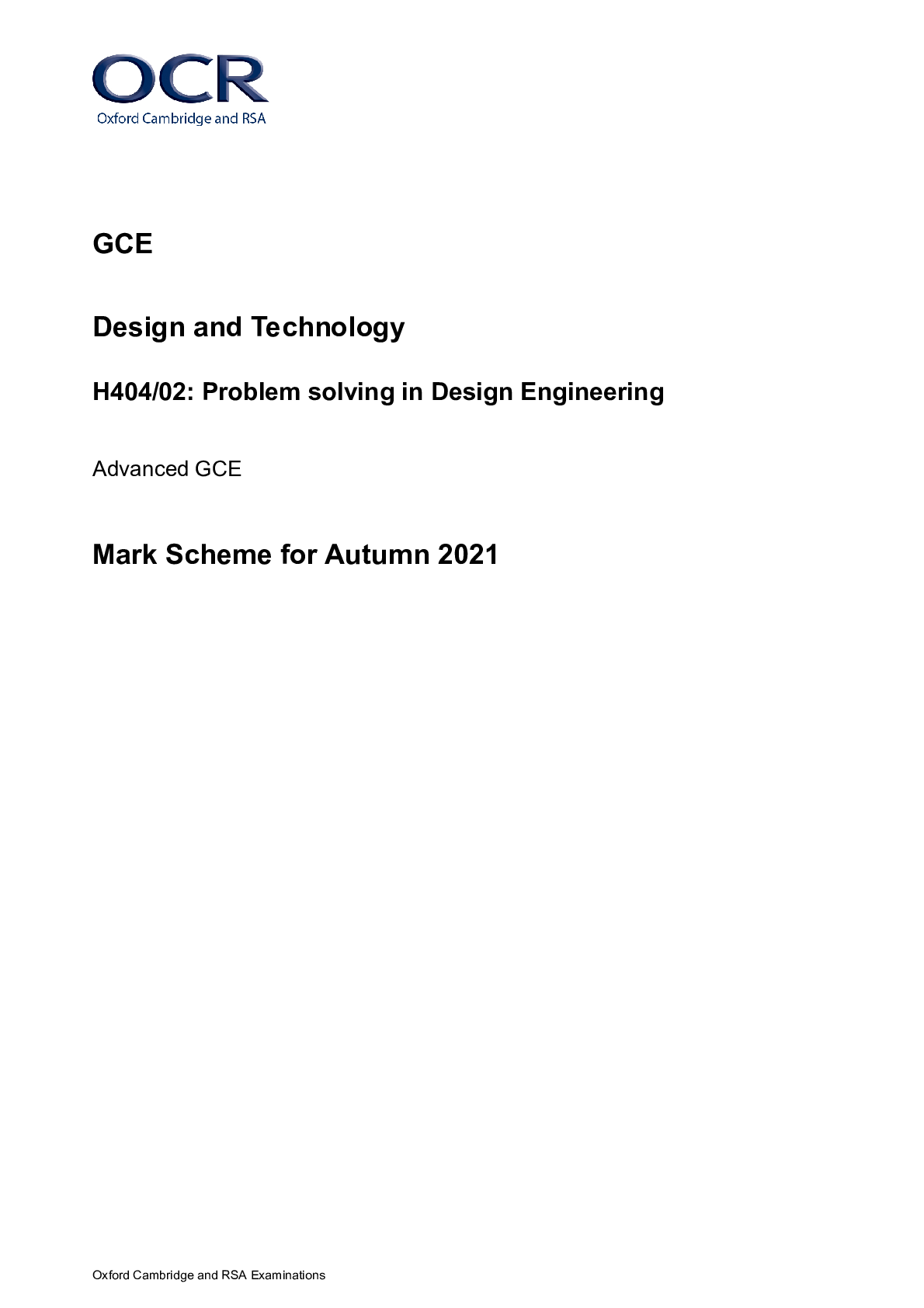








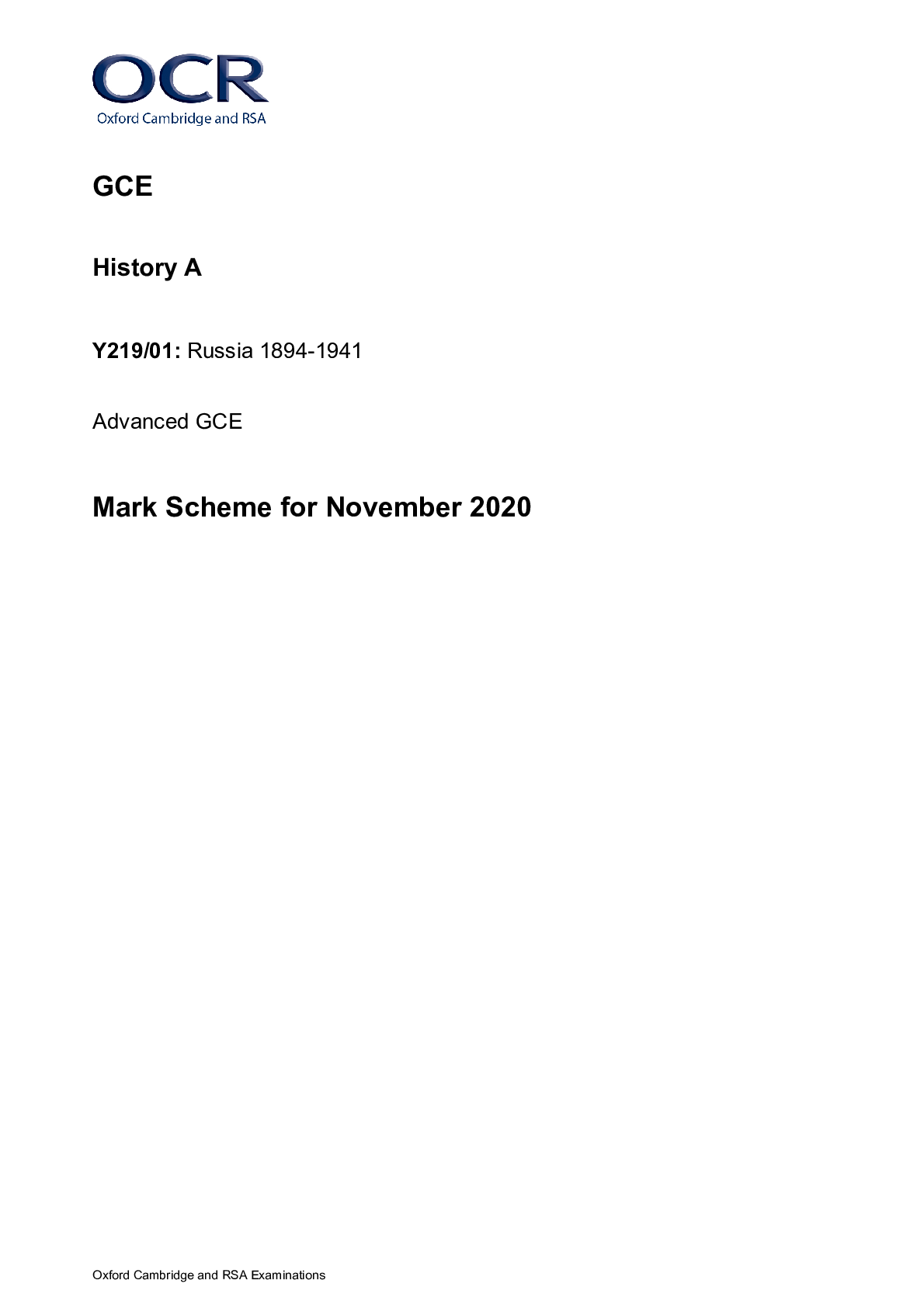
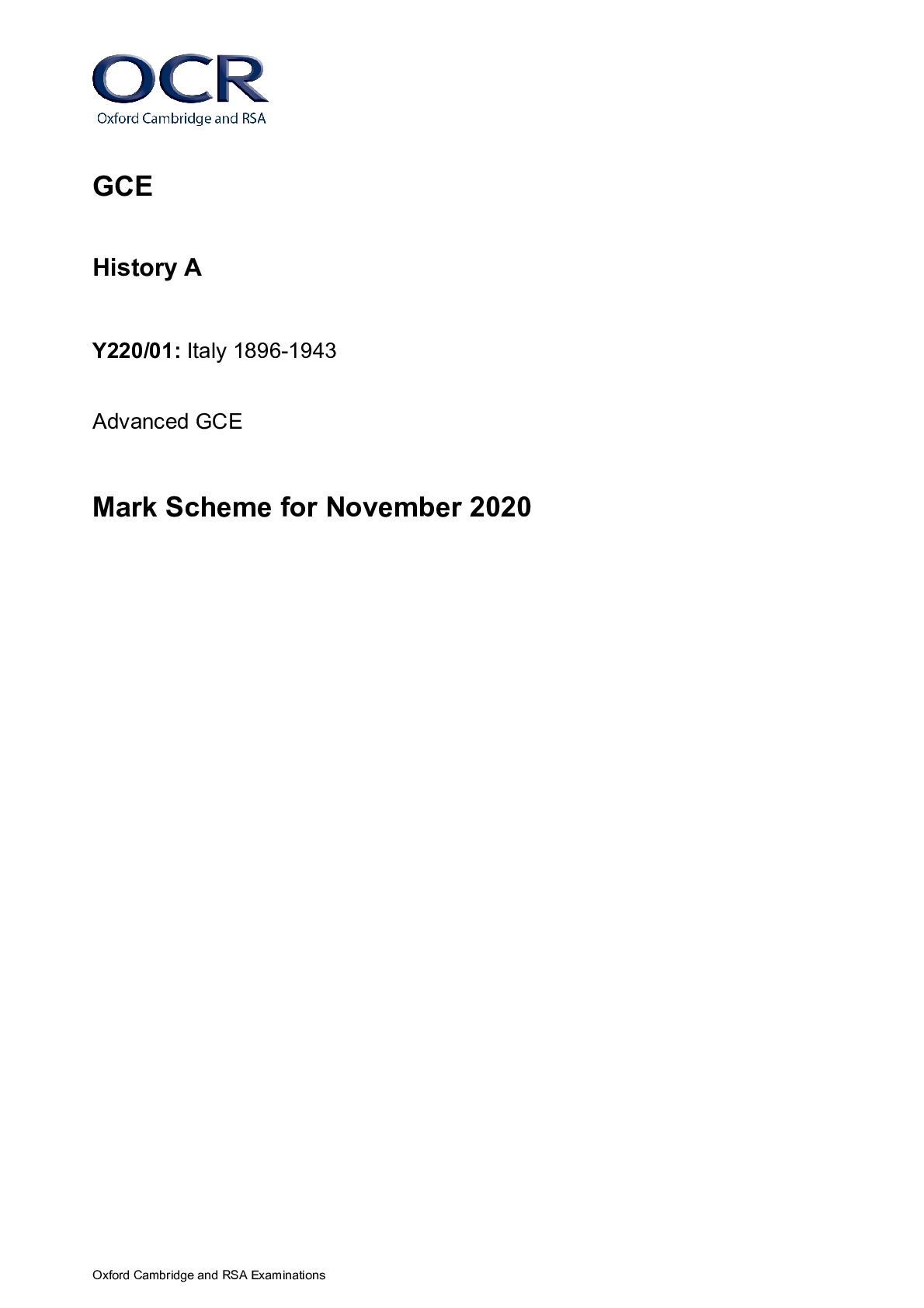

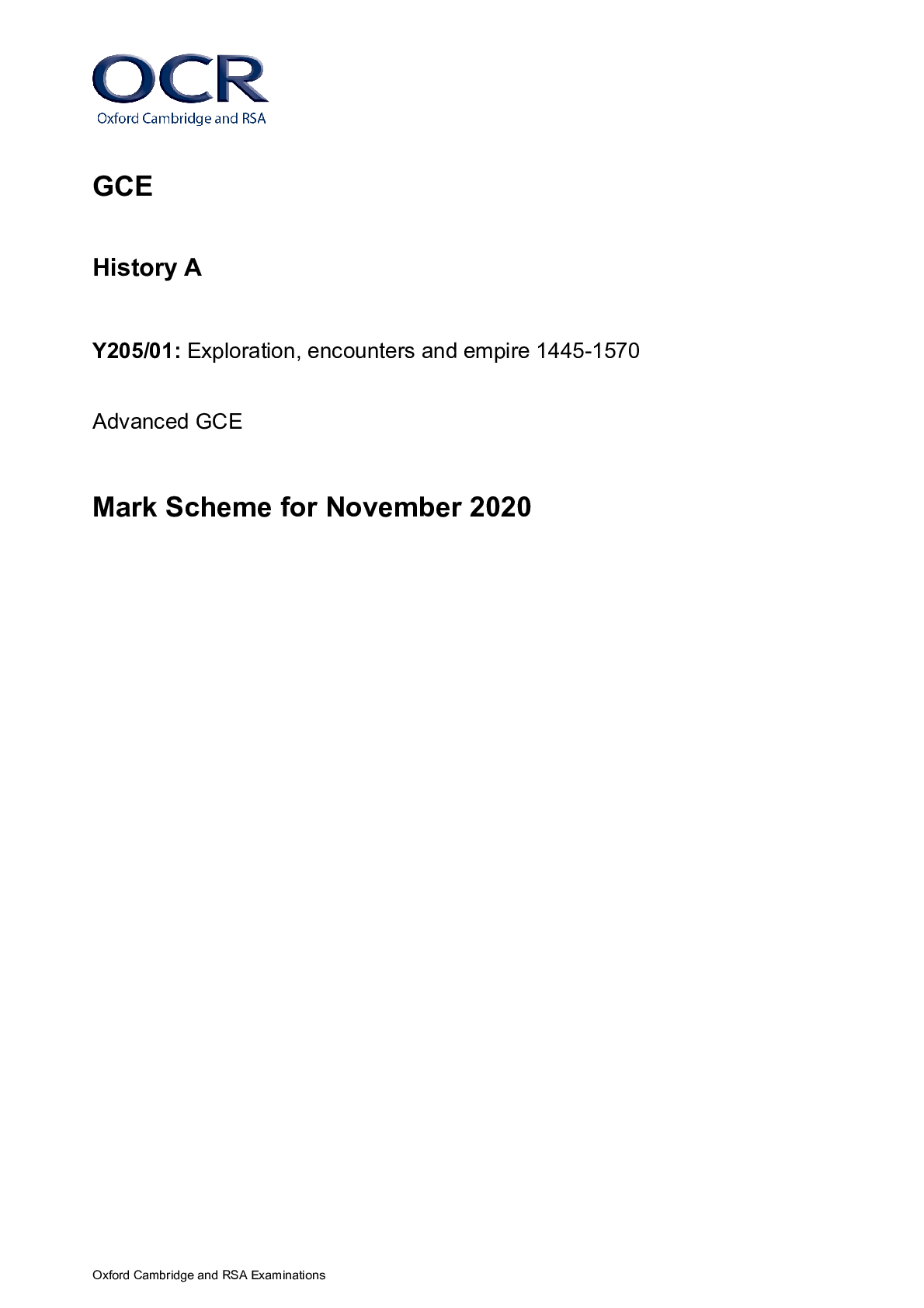
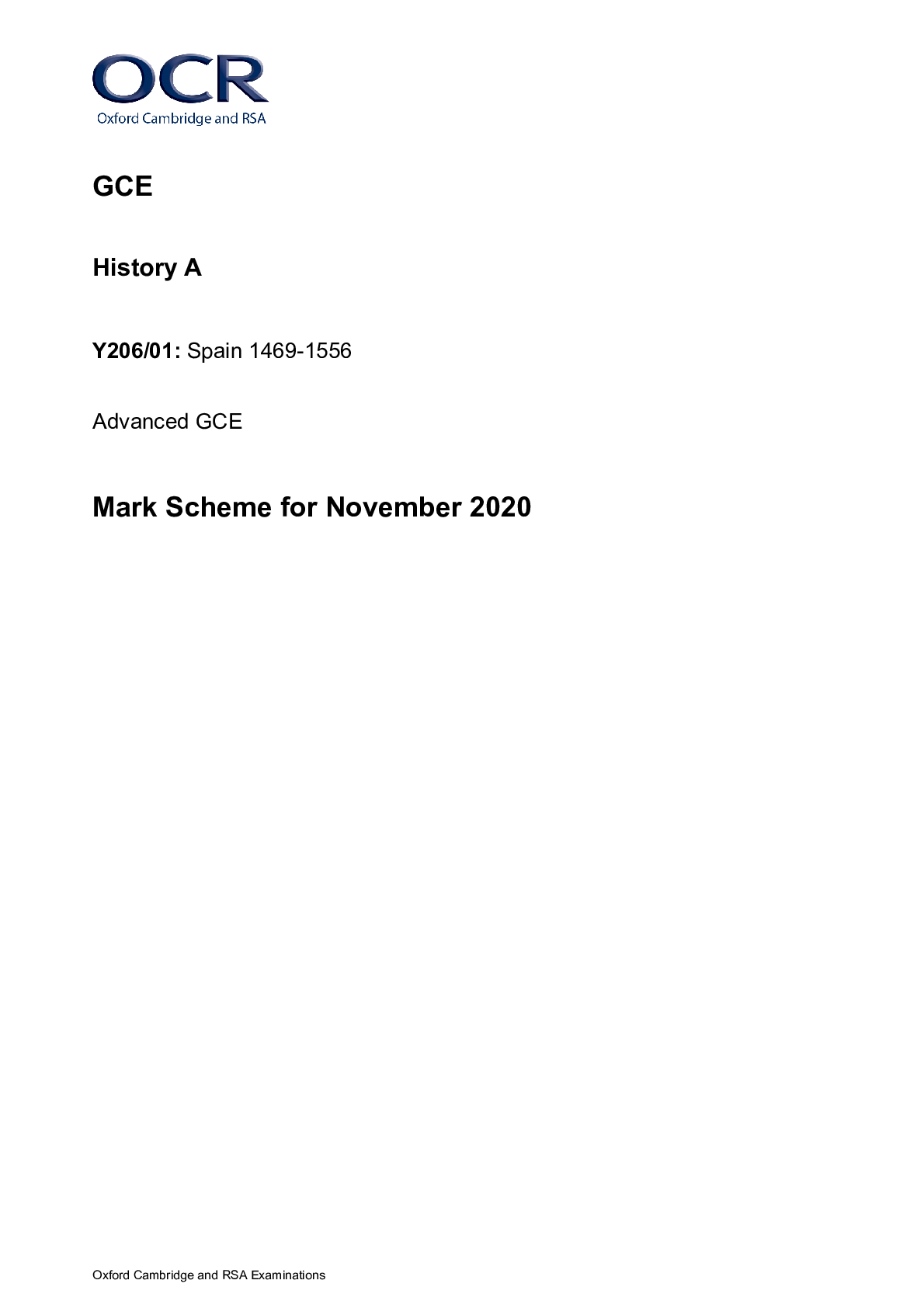
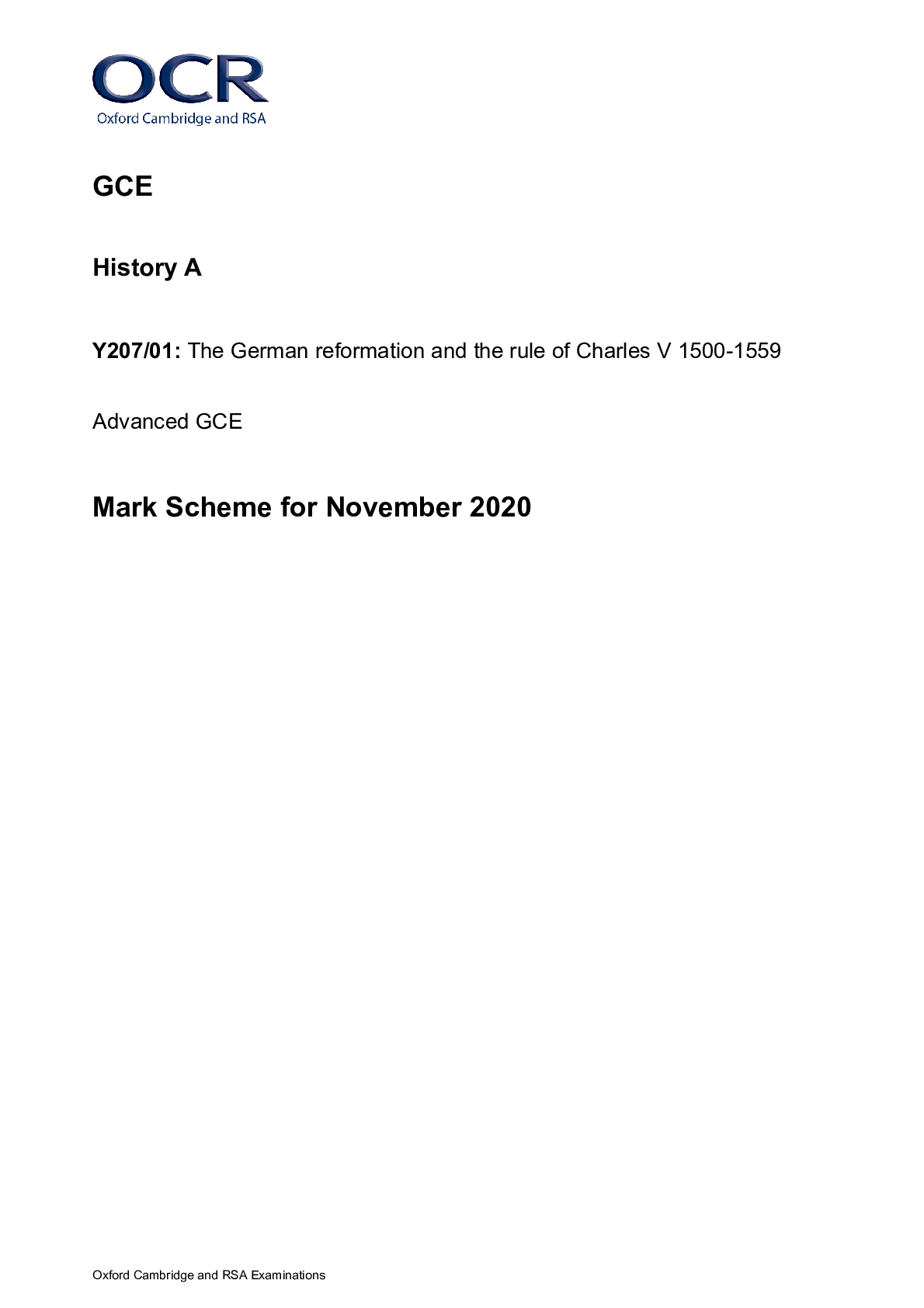
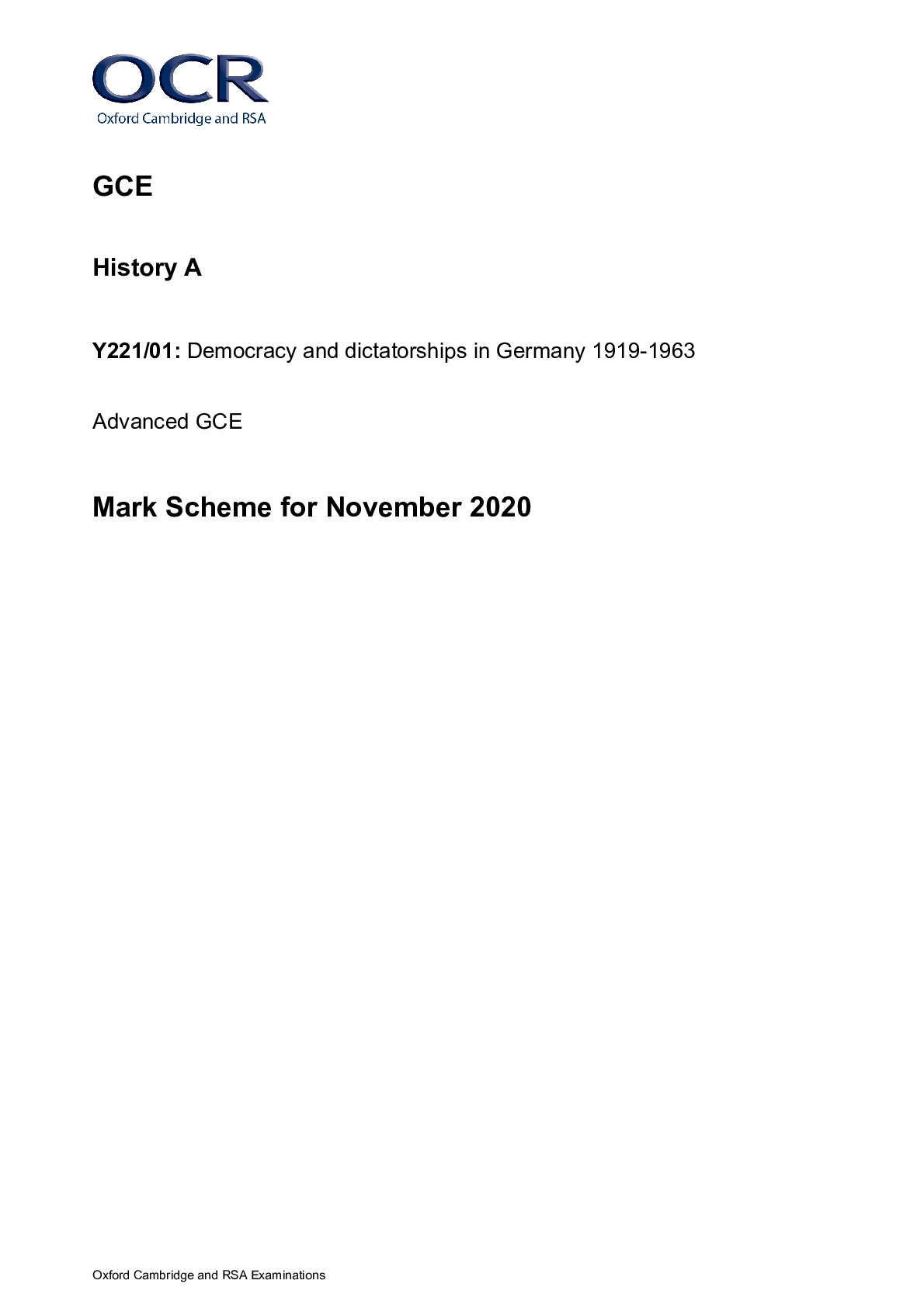

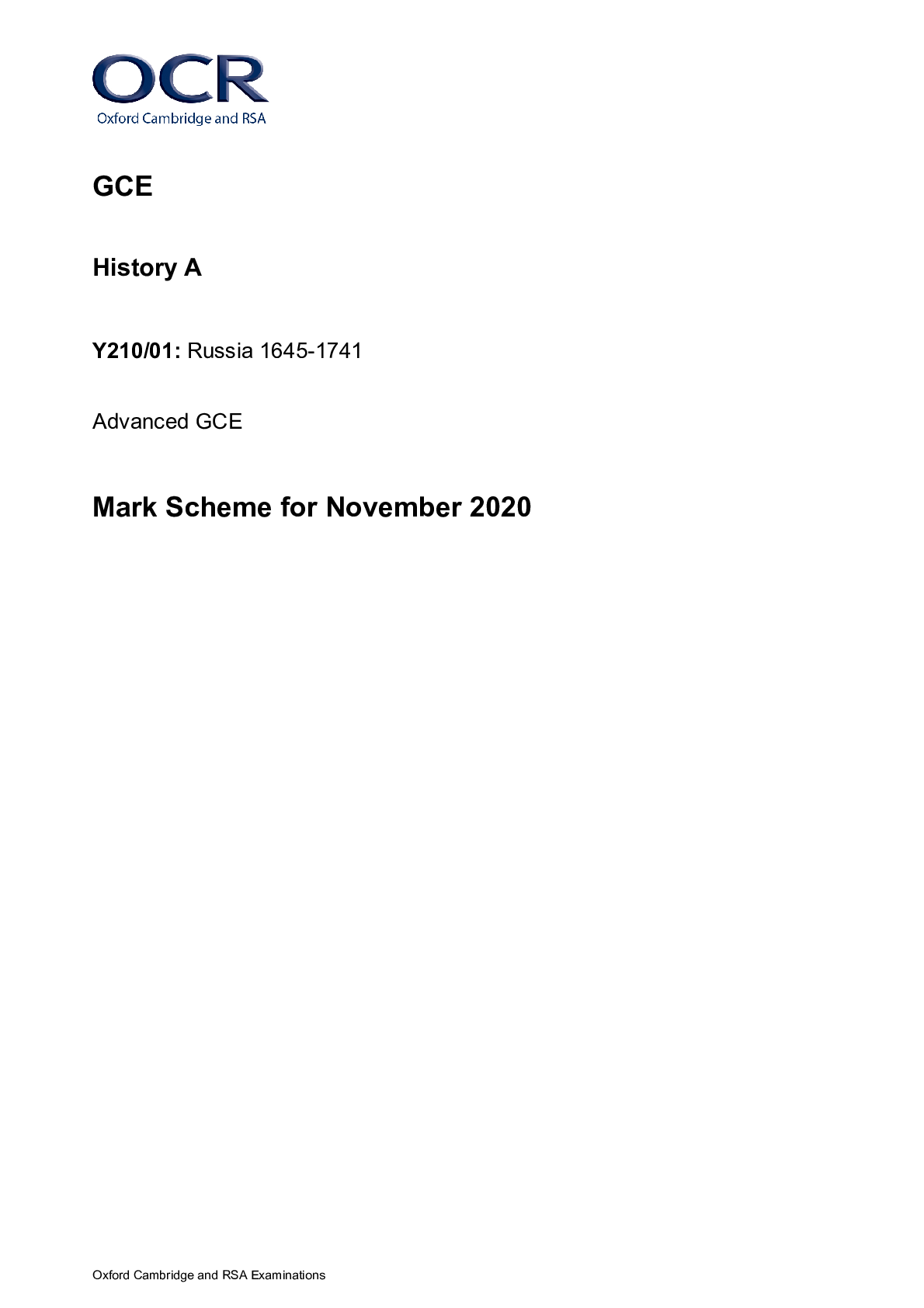


.png)






